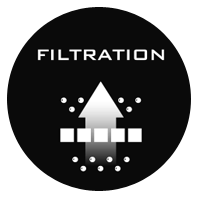Shell Construction
Most hot tubs and spas on the market today have an acrylic surface and a fiberglass substructure. Colorado experiences drastic shifts in temperature in very short time spans. All materials react to temperature shifts. As the temperature rises, materials expand and as the temperature falls, they contract.
- Fiberglass is rigid and reacts more slowly to temperature changes than acrylic. This leads to visible imperfections in the shell including boils, cracks or delamination.
- Manufacturers protect themselves from covering this type of damage by making exclusions to the warranty if the hot tub is exposed to direct sunlight, which most interpret as simply having it outside.
- Larger cracks can allow water to get between the acrylic and fiberglass and create conditions suitable for a bacterial growth. Wind River uses a high quality ABS (Acrylonitrile Butadiene Styrene) backed acrylic on their Colorado hot tubs. This material is twice as thick as standard acrylic and consists of 2 chemically bonded layers.
- The surface or cosmetic layer is the same as a fiberglass spa, but the substructure is a much denser heat resistant acrylic.
- The two materials are identical in the way they react to shifts in temperature, which eliminates the possibility of cracks and other surface imperfections.


